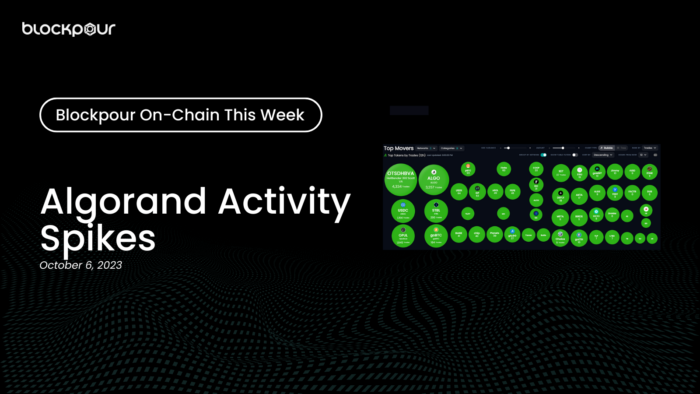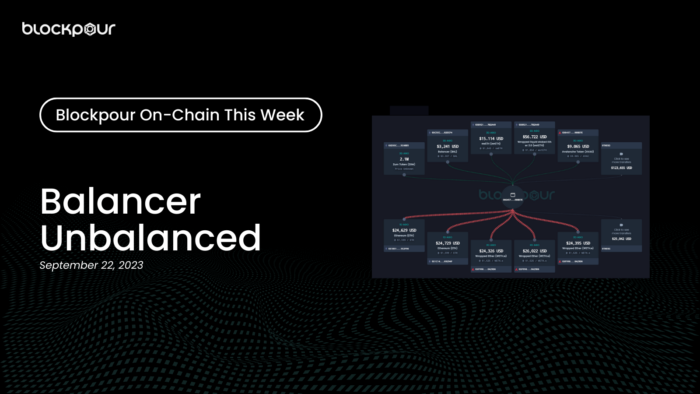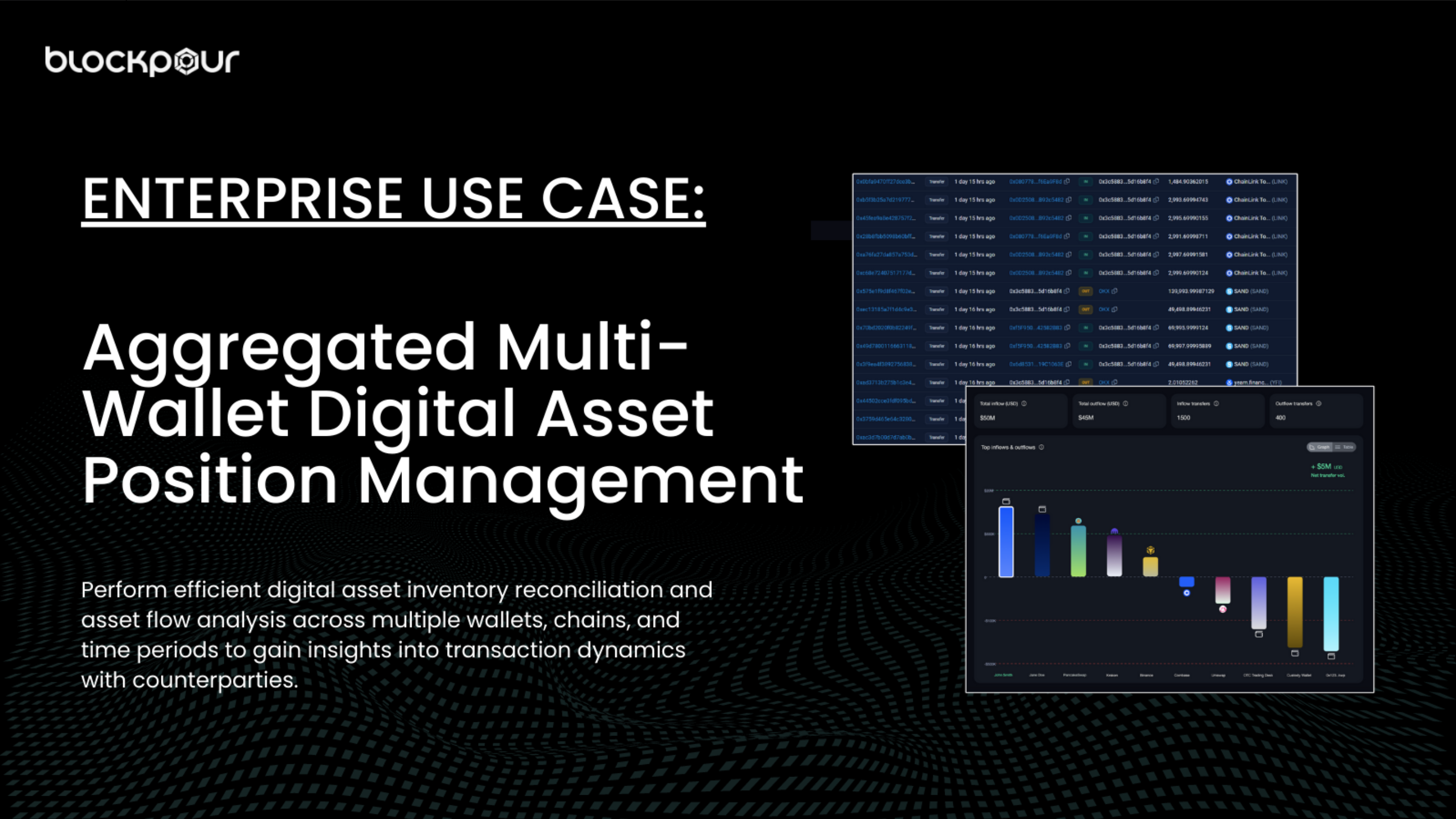Perform efficient digital asset inventory reconciliation and asset flow analysis across multiple wallets, chains, and time periods to gain insights into transaction dynamics with counterparties.
Table of Contents
Introduction
More and more of what used to be done only by traditional financial institutions is being relegated to far more accessible tokens, protocols, and blockchains. That greater level of accessibility to financial options for companies and their users is coupled with accounting that is magnitudes more complicated than the traditional options.
As discussed in our previous Use Case blog about blockchain transaction reconciliation, the expansion of decentralized applications (dApps) and the adoption of cryptocurrency and tokenized assets in the operations and on the balance sheets of institutions around the world have created a new set of headaches for middle-office managers.
For example, there are instances where a single wallet may be used on the Ethereum mainnet to swap $ETH for another token on a decentralized exchange (DEX) for a long position. However, operational security (opsec) measures across cohorts of on-chain participants and the increasing availability of cross-chain liquidity are making multi-wallet portfolio management a necessary burden to bear.
While the effort spent reconciling crypto wallet balances on all chains traded on is a necessary endeavor, the pain points associated with it do not have to be. This is why Blockpour Recon can perform multi-wallet portfolio management for enterprises and institutions looking to increase their on-chain activities without inheriting any more headaches trying to manage them.
The Challenges of Multi-Wallet Portfolio Management
We all know the stress put on middle-office managers to ensure that the company’s books stay balanced properly. Luckily, the records kept on chain are immutable and accessible 24 hours a day from anywhere around the world.
However, the convenience ends there.
Wallet Labeling & Portfolio Management
The first major challenge facing the people who reconcile multi-chain wallets of institutions and enterprises is figuring out with whom each of the wallets interacted, to, for example, execute an OTC trade. All wallet addresses on Ethereum and ERC-20-compatible chains start with ‘0x…’, followed by a series of random letters and numbers.
The current system of using hashes for identifying and tracking transactions on the Ethereum block explorer, Etherscan, can be difficult to navigate and comprehend, especially when dealing with a large number of transactions. The lack of clear labels for wallets adds to the challenge of verifying token movements for OTC trades. This not only creates eye strain for managers responsible for tracking these transactions but also increases the risk of errors. It is crucial to provide a more user-friendly experience and facilitate efficient tracking and verification of transactions.
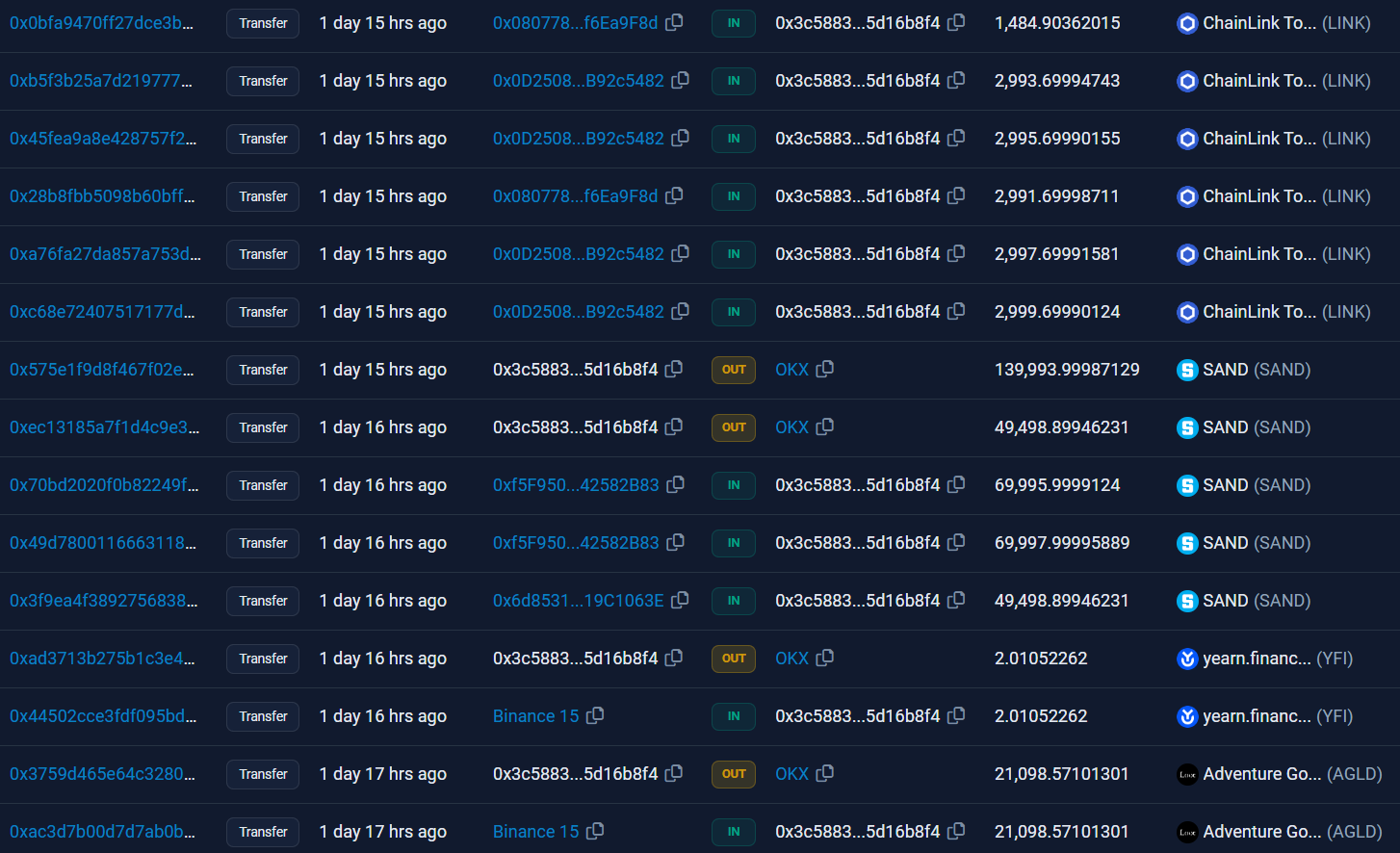
Some transactions from an Ethereum wallet as displayed by Etherscan.
As part of managing wallet-to-wallet transfers, tracking the value of a portfolio that may consist of tens of thousands of wallets poses another unique challenge to enterprises. This includes viewing token balances across multiple networks and their net USD value.
Consider the case of an OTC desk client with deposit addresses spread across multiple exchanges and liquidity providers. For middle office managers, tracking positions within these individual accounts becomes essential to ensure the completion of specific inflows and outflows and accurate accounting of all the firm's assets, even if they reside in third-party wallets.
Reconciling blockchain balances is a common requirement observed in various digital asset businesses that Blockpour has engaged with. This process involves calculating daily net asset values of on-chain balances, verifying their alignment with company records, and validating any differences in positions and values between consecutive days. The process also tends to be manual, making reconciliation of inventory and positions extremely challenging and error-prone, particularly when there is an operational need to reconcile the books against the blockchains daily.
For well-established digital asset businesses, the use of in-house systems for automated blockchain balance retrieval through direct integration may be prevalent. However, with the continuous expansion of the digital asset space, accommodating more chains, new data types and standards, smart contract upgrades, and counterparties facilitating diverse transactions becomes increasingly challenging for in-house development teams.
As businesses seek to grow their market share by supporting new digital assets, chains, and on-chain events, maintaining consistent integration into their books and records system becomes crucial and must be carefully factored into project planning. This could delay time to market and strain valuable resources that could be allocated to other essential activities.
The backlog of integration development can lead to offline tracking while business teams await the completion of development tasks, which increases the possibility of errors in the overall data management process.
Counterparty Interactions
On a more detailed level, the absence of wallet labels on familiar block explorers presents significant challenges for firms to accurately identify the clients and counterparties involved in their transactions and discern abnormal or potentially unsanctioned asset movements when viewed in aggregate.
Moreover, the publicly available wallet labels often fail to encompass the addresses of KYC'ed clients and counterparties that firms need to track for operational and regulatory purposes. As a result, the true extent of asset flows remains obscured, especially considering the vast number of wallet addresses that a single individual or entity may possess. This lack of proper integration between publicly available labels and addresses of interest can lead to inefficiencies in data management and compliance efforts, hindering firms from gaining a comprehensive view of their asset movements.
From an operational perspective, understanding the top inflow and outflow of assets is crucial for digital asset businesses to efficiently manage their day-to-day operations and ensure seamless transactional processes. The absence of a unified data solution that analyzes asset flows between all an entity’s wallets and the networks it interacts with breeds fragmented information sets and potential data discrepancies.
This can ultimately hinder businesses from gaining a comprehensive understanding of their asset movements, impeding their ability to identify patterns, detect anomalies, and optimize operational efficiency.
The Solution with Blockpour Recon
Blockpour Recon, the primary toolkit that powers Blockpour Enterprise, is a purpose-built solution to all the challenges middle and back-office managers face when managing multi-chain portfolios. The Blockpour team has had countless conversations with its stakeholders and partners to determine the specific functionalities that Blockpour Recon should feature to streamline portfolio management with comprehensive wallet labeling and counterparty interaction identification.
Among the key concerns expressed by enterprise firms that Blockpour has spoken with is the inability to efficiently track their own portfolios. Blockpour Recon addresses this and several other problems by providing a comprehensive view of digital asset balances across multiple wallets and chains, allowing efficient inventory tracking across time periods. Additionally, Blockpour Recon visualizes the flow of assets in and out of entities and wallets, enabling insights into transaction dynamics with counterparties.
Creating On-Chain Identity Profiles
At the core of Blockpour Recon lies the robust wallet labeling system, which allows businesses to create and maintain comprehensive on-chain identity profiles by associating relevant entities like customers, internal divisions, and counterparties with KYC’ed wallet addresses.
Building on Blockpour’s extensive library of pre-labeled wallets of CEXes, market makers, DEXes, and other on-chain entities enables enterprises to further customize wallet labels according to their specific preferences and business requirements.
In essence, clients can automatically aggregate on-chain activities by a specific group of wallet addresses across blockchain networks, and create comprehensive on-chain records in highly relevant perspectives for the enterprise.

The above image showcases Blockpour Recon’s wallet label management system, which provides effortless querying of existing identity profiles based on any attribute and an intuitive interface for ongoing management. Our enterprise clients have the flexibility to tailor profiles to include wallet labels that align with their unique business needs. This versatile configuration ensures the smooth integration of custom wallet labels to a wide range of use cases with ease and precision.
View a Complete Portfolio Overview
The Portfolio Overview feature on Blockpour Recon gives enterprises comprehensive insights into the balances on their digital asset wallets and their fiat values across chains. This is a crucial aspect for managers tasked with keeping track of company books and reporting to stakeholders.

Blockpour Recon’s portfolio dashboard streamlines the inventory reconciliation process by providing a clear view of the net asset value of aggregated digital assets over time. Enterprises can conduct granular investigations through the dashboard's advanced filters, easily automating the reconciliation of blockchain positions over any specified timeframe by entities, networks, wallets, and tokens.
With the Portfolio Overview, users can address common requirements among digital asset businesses, offering a verifiable source of truth for on-chain balances across multiple wallets and chains. By automating the retrieval and consolidation of data, enterprises can significantly save time and resources while ensuring compliance and operational efficiency. With this streamlined process, businesses can focus on deriving valuable insights from the data to maximize productivity and make informed decisions with confidence.
Understand Asset Flows with Aggregated Token Flow Analysis
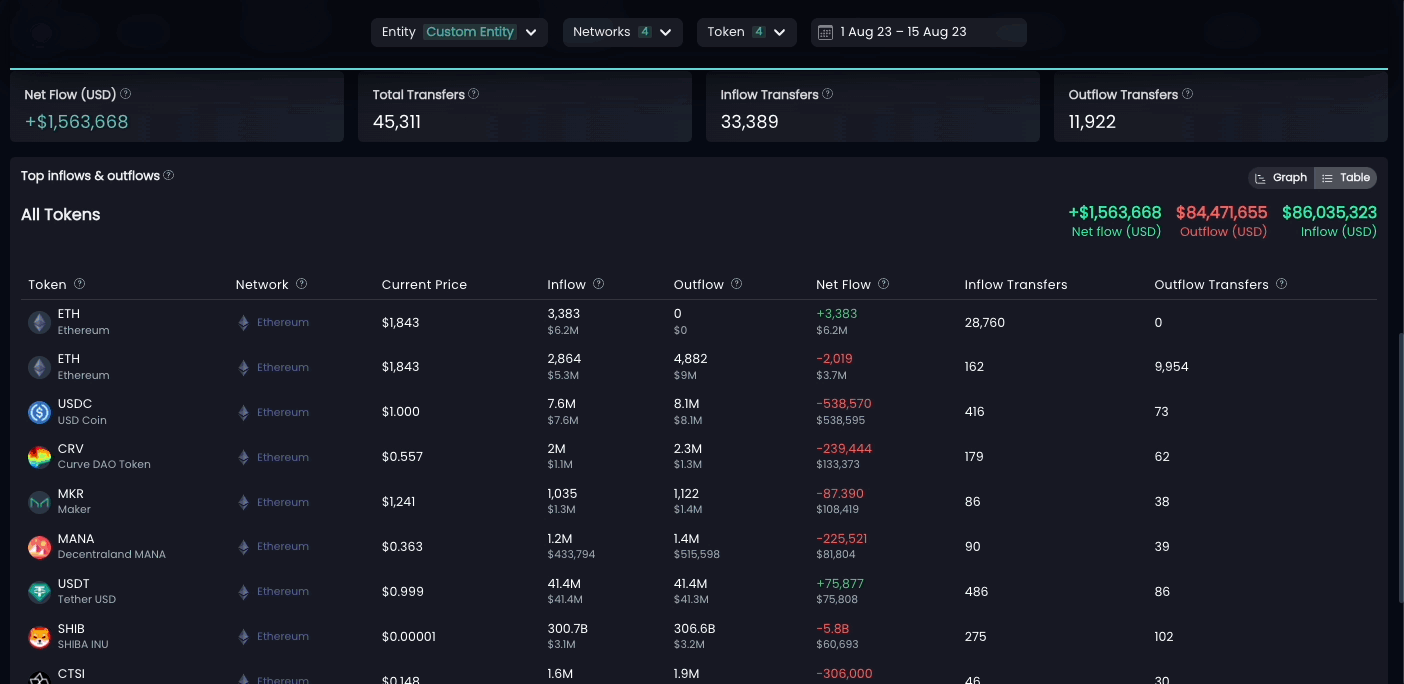
The Top Inflows and Outflows feature in Blockpour Recon provides valuable insights into the largest inflows and outflows of digital assets within an organization's wallets. By identifying the top asset movements through customized on-chain identity profiles, businesses can gain a deeper understanding of the flow of funds in order to detect abnormalities or suspicious activities. The feature presents this information in a clear and organized manner, allowing users to easily track and analyze the asset flows that have the most significant impact on their digital asset holdings. This powerful tool enhances risk management, compliance efforts, and overall financial decision-making, empowering businesses to stay ahead in the dynamic world of digital assets.
With all these capabilities directly accessible on the platform, users can continuously monitor and investigate abnormal transactions and patterns of KYC'ed entities, eliminating the need to switch between multiple platforms for accessing KYC information, on-chain history, and compliance indicators.
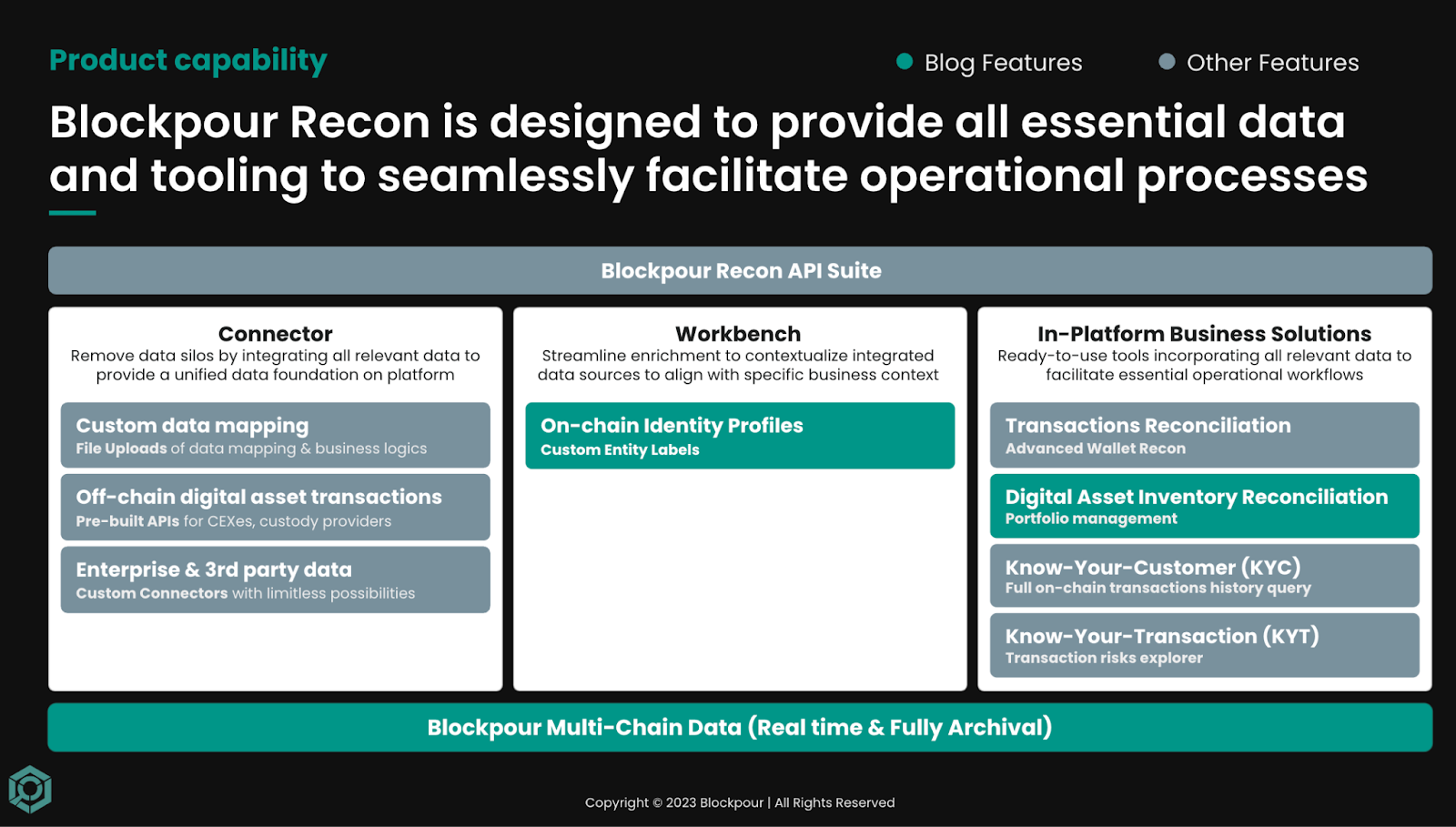
Conclusion
With Its robust set of specifically curated features and tooling, Blockpour Recon eliminates data silo issues within an enterprise and facilitates efficient information sharing between operational processes. These integrative efforts aim to reduce or eliminate the need for costly custom in-house solutions and minimize investments in multiple specialized systems dedicated to different aspects of the process, ultimately enabling businesses to redirect valuable resources to achieve their commercial objectives.
About Blockpour
Blockpour is a technology firm specializing in Web3 data and analytics, offering individuals and businesses indispensable data and tools to navigate the dynamic on-chain universe while bridging seamlessly to the off-chain world.
Through our real-time and historical multi-chain data feeds, businesses and traders can fully unlock the power of blockchain data to inform their strategies, optimize operational efficiency, and drive top-line growth.
To learn more about Blockpour check out our website and follow us on Twitter or LinkedIn. For sales or inquiries about the API, contact [email protected].
Disclaimer
The above article is for informational purposes only and is not financial advice. Blockpour is a data aggregation and analytics platform only and does not provide financial advice or services of any kind.
